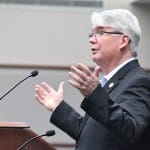Bloomington’s mayor pitches half percent countywide income tax increase to generate $8M annually for climate action




A proposal to increase the local income tax (LIT) that’s collected in Monroe County by a half percent came from Bloomington’s mayor, John Hamilton, after swearing-in ceremonies for the city’s 11 elected official were complete on New Year’s Day.
The half percent increase would bring the total income tax levy to 1.845 percent from the current total of 1.345 percent. It’s estimated to generate about $8 million for allocation by Bloomington’s city government and another $8 million for Monroe County government officials.
Hamilton wants the tax to be enacted by the local income tax council (LITC) sometime in the next six months. It’s not not yet clear what, if any, deadlines might need to be hit to ensure that new LIT revenue would appear in local coffers as soon as possible.
Hamilton called for the city to use the new LIT to establish a sustainability fund that would be “focused on supporting mitigation and adaptation in the face of climate change, as well as climate justice and inclusion for all.”
Hamilton said details are still to be worked out, but gave examples of general expenditure areas: public transportation, mobility and demand management, public and private buildings and infrastructure, clean energy and affordable housing.
Some of those details might be sorted out by a climate change working group, that Hamilton dubbed a “green ribbon panel,” which he wants formed in the next 100 days. The panel would include government, private sector, nonprofits and the education sector, Hamilton said.
It’s the local income tax council (LITC) that has the legal authority to adopt a higher income tax rate. And the LITC includes the fiscal bodies of the county and all cities and towns. Voting shares for the fiscal bodies are apportioned by population, so Bloomington’s city council, as its fiscal body, controls 58 percent of the LITC vote.
That means it will be Bloomington’s city council that needs to decide whether to enact the tax that the mayor described in his remarks. Hamilton’s proposal appeared to have strong support from city council and county councilmembers with whom The Beacon spoke immediately following the mayor’s remarks, in part because some of them have already been pushing for the move.
City councilmember Steve Volan said the idea that he’d advocated was a higher LIT focused just on transit. So the mayor’s proposal was simply broader, Volan said. At least half the additional revenue should be spent on local transit, Volan said.
That could mean adding $4 million to Bloomington Transit’s budget, which was approved at around $14 million for 2020. The possibility of 30 percent more funding for public buses will almost certainly have an impact on Bloomington Transit’s current planning. The BT board is now contemplating changes to routes to optimize them for ridership, but the changes are based an assumption that revenue will not increase.
The tradeoffs required to optimize service to increase ridership might not be necessary if more funding is available. The BT board is expected in the next month or so to make decisions on the August 2020 implementation.
City councilmember Dave Rollo told The Beacon, he’d been “harping on” the idea of increasing the LIT quite a bit with the mayor. “We need to find dedicated funding for this…if we’re serious about getting to zero emissions,” Rollo said. “We have a climate emergency,” Rollo said.
With it’s 58-percent majority on the local income tax council, the city council doesn’t need to collaborate with county officials in order to get a LIT increase passed. Asked if there weren’t still politics to consider, Rollo pointed to the recent unanimity among city and county officials on the the question of a required energy efficient design for the planned expansion of the convention center.
County councilor Geoff McKim said it’d be the county council that needs to come up with a good plan for how to use the county’s share of the additional funding. An increase of 0.5 percent would translate to an additional $8 million a year that the county council could put into its budget.
The additional revenue could not be could be tapped for general fund type expenditures. [See comment below.]
Hamilton’s plan calls for an increase in the “economic development” category under the “expenditure rates” of LIT that are allowed under the state statute. Monroe County doesn’t currently levy any LIT in the “economic development” category. Monroe county now levies 0.9482 percent for “certified shares” (general fund type expenditure) and 0.25 for public safety.
The fourth category under the “expenditure rate” LIT is “corrections.” That’s another category for which no LIT is currently levied. But it’s a category that could be eyed in the near future to fund recommendations that come out of a criminal justice reform study that’s currently being conducted. In light of Hamilton’s announcement, county officials might start trying to get a ballpark idea for the amount of funding that could be needed to pay for criminal justice reforms.
The cumulative cap for “expenditure rate” LIT is 2.5 percent. If an additional 0.5 percent were levied in the “economic development” category, it would bring the total levy to about 1.7 percent. That’s another 0.7 percent in taxing capacity that would still be available to fund other initiatives.
Council councilor Trent Deckard told The Beacon he was interested in what the mayor had to say: “We talk about sustainability. But what do we do?” If the additional LIT were levied, the county council would need to look at the whole county and ask what benefit county residents, Deckard said. He pointed out that a lot of Monroe County’s natural resources are not inside the city limits.
Deckard and the other at-large county councilors—McKim and Cheryl Munson—are seeking re-election in 2020. Asked if the LIT increase could become a campaign issue Deckard said, “The reality is, I don’t think you can run right now and sustainability with real teeth in it, not be part of the discussion.”
As for any possible political friction between the city and the county over a LIT increase, Deckard pointed to the public safety LIT process. The city council’s involvement with the the public safety LIT decisions had a really good history, Deckard said. In the last round of allocations, city representatives turned over the assessment of public safety funding requests from non-city entities to the non-city members of the public safety LIT committee.
Deckard added that Hamilton had reached out to county councilmembers the night before, to give them a heads up to give them an idea his announcement was coming. Deckard appreciated the gesture from the mayor. “We have to work together,” Deckard said.




Comments ()